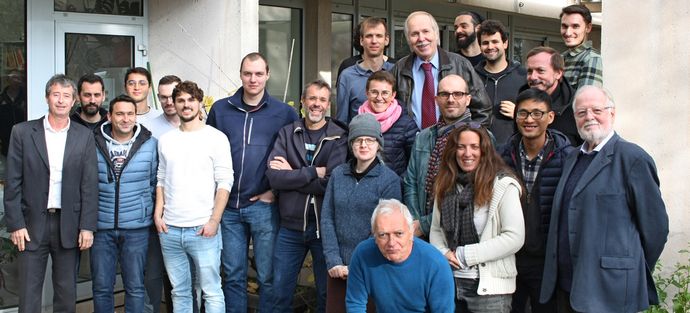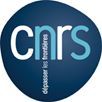Doctoral program DFDK-05-06 Bochum-Nice of the Franco-German University
How young physicists in Bochum and Nice become high-tech PhDs
Have you also wondered in recent years where the "new" blue and white light emitting diodes (LEDs) come from? Did they fall from Mars or were they "suddenly" invented? No, there is an impressive scientific story behind them, which is far from over and which we are continuing to work on successfully. In a binational doctoral program between the Ruhr University Bochum and the University of Nice - Sophia Antipolis in France, young physicists complete their doctorates in three languages - German and French in the laboratory, English in publications. They not only conduct research at the forefront of state-of-the-art semiconductor technology but also acquire key international qualifications that prepare them for a global, polyglot career in research, development, marketing, or management.

Group photo of the mini-workshop participants in October 2019 at the Université Côte d'Azur. From left to right: Jean-Yves Duboz, Maxime Hugues, Patrice Genevet, Antoine Barbier-Cueil, Timo Kruck, Nikolai Spitzer, Hans-Georg Babin, Fabrice Semond, Camille Lagoin, Nikita Nikitskiy, Stéphanie Renesson, Philippe Vennéguèz, Andreas Wieck, Antoine Reserbat-Plantey, Hélène Rotella, Pierre Marie Coulon, Renato Juliano Martins, Minh Tuan Dau, François Dubin, Peter Zajac, Borge Vinter
History, motivation, and field of work:
The 2014 Nobel Prize in Physics was awarded to Shuji Nakamura, Hiroshi Amano and Isamu Akasaki for inventing the blue light-emitting diode made of gallium nitride (GaN), which they made around 1995. Our Franco-German doctoral program (DFDK-05-06) has been researching precisely this semiconductor system since it began in 2007 to produce it more perfectly through improved crystal growth and to transfer it into nanostructures, which should enable quantum mechanical effects to be used even at room temperature. The French partner CRHEA of the CNRS in Nice has focused on GaN for over 15 years, making it one of the most experienced and largest European institutes with global visibility in this field. The Nobel Prize awarded to the three Japanese colleagues in 2014 underlines this activity in a highly topical way and brings our research program more into the public eye, both in terms of application and basic research. GaN is a semiconductor with a large band gap that can emit photons in the ultraviolet range. By adding indium to InxGa1-xN, this emission is shifted into the visible blue. This is the material that today supports LED technology, which will replace all fluorescent lamps in the foreseeable future and - even through European legislation - has already replaced incandescent lamps. In addition to the lighting aspect, high-frequency technology is also currently being revolutionized with these semiconductors, which find a broad market in mobile phones and their relay stations, for example. It is therefore highly relevant to bring scientifically educated researchers with doctorates onto the labor market to guarantee the key know-how of this semiconductor technology in the responsible minds of tomorrow. This applies in particular to the two European heavyweight countries of Germany and France, where the majority of the continent's industry is based.
Based on this situation, the Franco-German doctoral college (also known as the Collège Doctorale Fanco-Allemand CDFA-05-06) of the Franco-German University DFH/UFA has set itself the task of enabling young academics in the doctoral phase to conduct binational research in which they study the growth of these semiconductors, optimize them scientifically and explore further improvements and functionalities by nano structuring these materials, e.g. also for the quantum information processing of future supercomputers.
These prospects still harbor enormous scientific potential, even though blue LEDs have been produced in the trillions for some time now. The reason for this is that the epitaxy of GaN-based layers is still far from perfect, despite its great commercial success, due to the lattice mismatch of common substrates and the stoichiometric integration of the gaseous nitrogen. We are already successfully trying to eliminate the first difficulty by homoepitaxy on GaN substrates. The new French head of the CDFA, Dr Jean-Michel Chauveau, is pursuing the same approach very successfully with ZnO, which is a very promising prospect for the future of the college. We are also aiming for white light emission in the semiconductor crystal: Up to now, blue LED light has been converted into the broader, white spectrum using phosphors (as in tube lamps), which is of course not very efficient and therefore still has room for further development. It can therefore be expected that the efficiency and service life of LEDs can be further increased through continuous improvements in epitaxy. In particular, the transfer of the "band gap engineering" developed primarily on GaAs to nitrides harbors an application for quantum devices through higher confinement energies and exciton binding energy, which can then also function at room temperature. In the following funding period 2025 - 2028, the focus will be on a medical-physical application of GaN in the jointly applied MATRIX project.
MATRIX project
In recent years, under the leadership of Prof. Jean-Yves Duboz, we have been preparing a Franco-German research project to investigate the two-dimensional detection of proton beams for medical research and therapy. This symbiosis between semiconductor research and medical physics was initiated in intensive and enriching discussions between our locations. Prof. Duboz has established good connections with the therapy center in Lacassagne and its co-applicants; A. Wieck has many years of experience with lectures on medical physics at the RUB and Dr. Bäumer from the West German Proton Therapy Centre in Essen as a co-applicant. We are delighted to have been awarded this project thanks to years of excellent preparatory work. In this doctoral program, GaN-based semiconductor diodes are manufactured, characterized, optimized, produced, and integrated into pixel matrices, which can then detect proton beams and image beam cross-sections in a similar way to a digital camera. Such proton beams are used in medical accelerator laboratories in Essen (Germany) and Nice (France) for the radiotherapy of tumors and represent the most modern and promising therapy for cancer. Until now, patient throughput, i.e. the availability of this expensive technology, has also been limited by the fact that beam localization has been inadequate. GaN detectors can achieve significant progress in terms of equipment due to their increased service life, which is the subject of this doctoral program.
Contact: andreas.wieck@rub.de, 00 49 234 322 6726





